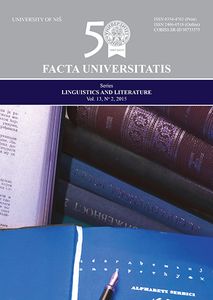A LINGUISTIC CONSTRUCT INFORMS MUSICOLOGY: RANKING METRICAL CONSTRAINTS IN MUSIC PERCEPTION
A LINGUISTIC CONSTRUCT INFORMS MUSICOLOGY: RANKING METRICAL CONSTRAINTS IN MUSIC PERCEPTION
Author(s): Mihailo AntovićSubject(s): Theoretical Linguistics
Published by: Универзитет у Нишу
Keywords: musical meter; preference rules; constraints; optimality theory; generative theory of tonal music
Summary/Abstract: The construct of perceptual constraints has become increasingly important in cognitive science in recent years, including the research at the intersection of linguistics and musicology. The present paper provides the results of an empirical study into the ordering of metrical preference rules/constraints from the group MPR5, as proposed in "A Generative Theory of Tonal Music" (GTTM, Lerdahl & Jackendoff, 1983). The theory predicts a preference for inferring strong beats on musical tones which exhibit a relatively prominent pitch change, dynamic, long slur, long pattern of articulation, long duration of a pitch in the relevant levels of a time-span reduction, and prominent harmony in the relevant level of a time-span reduction. A hundred and twenty randomly selected undergraduate students (30 musicians and 90 nonmusicians) were played twelve metrical sequences based on the examples of the rule MPR5 from GTTM, of which one half were constructed so as to comply with the participants' expectancies and another half so as to contradict them. The participants were prompted to press a button when certain they had heard a stressed beat. The distributions of responses suggest that the six constraints can be ranked into three larger groups, as follows: physical stress (dynamic, harmony), melodic stress (pitch, slur, length), ornamental stress (articulation). Musicians achieved better results than nonmusicians, and the response latencies considerably rose in the stimuli contradicting expectancies, but the internal constraint rankings remained relatively stable irrespective of the two factors (musical training and inception of stimuli on the targeted beat). Given such results, metrical segmentation is hypothesized to be the principal contribution of GTTM which has stood the test of time.
Journal: FACTA UNIVERSITATIS - Linguistics and Literature
- Issue Year: 13/2015
- Issue No: 2
- Page Range: 77-93
- Page Count: 17
- Language: English

